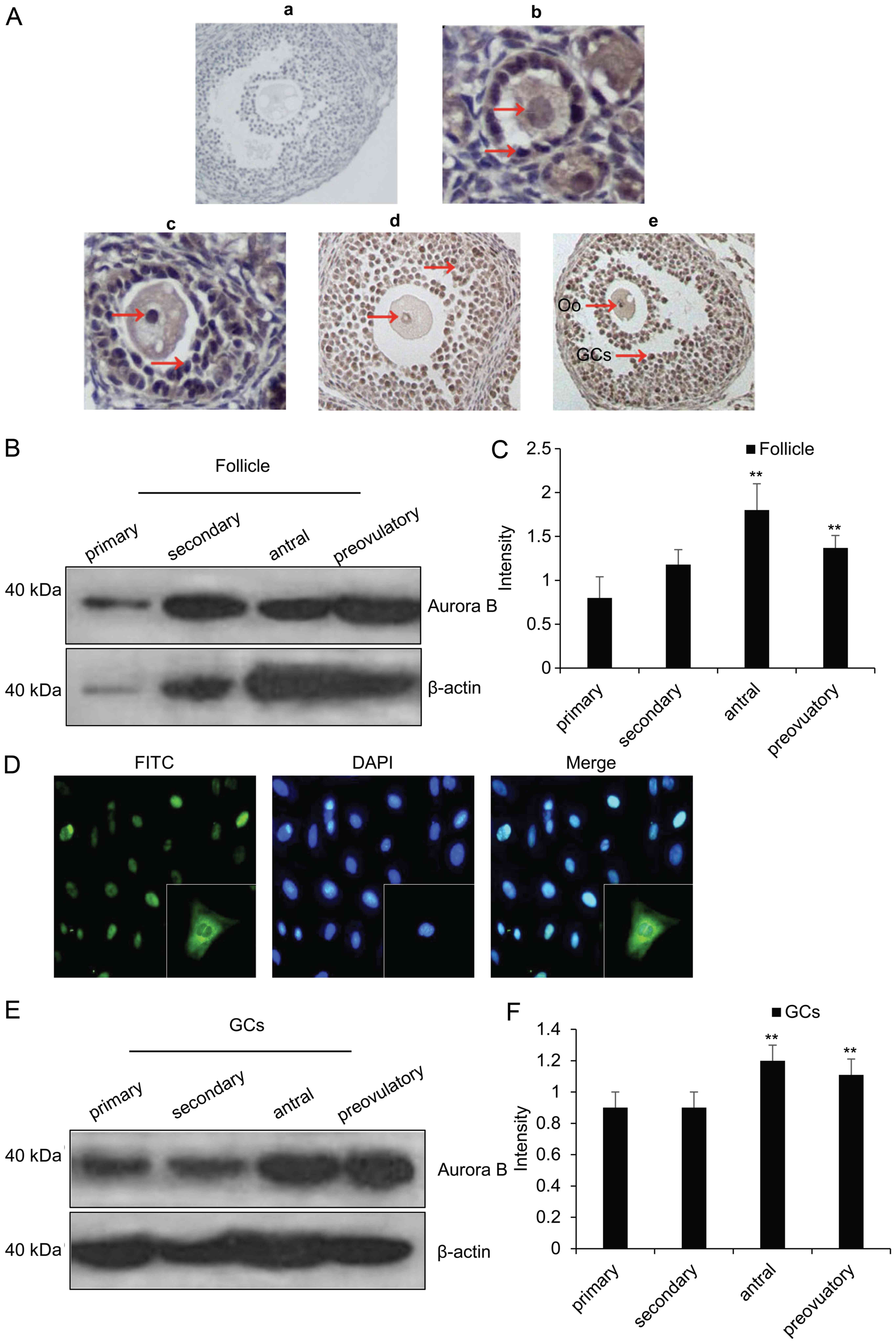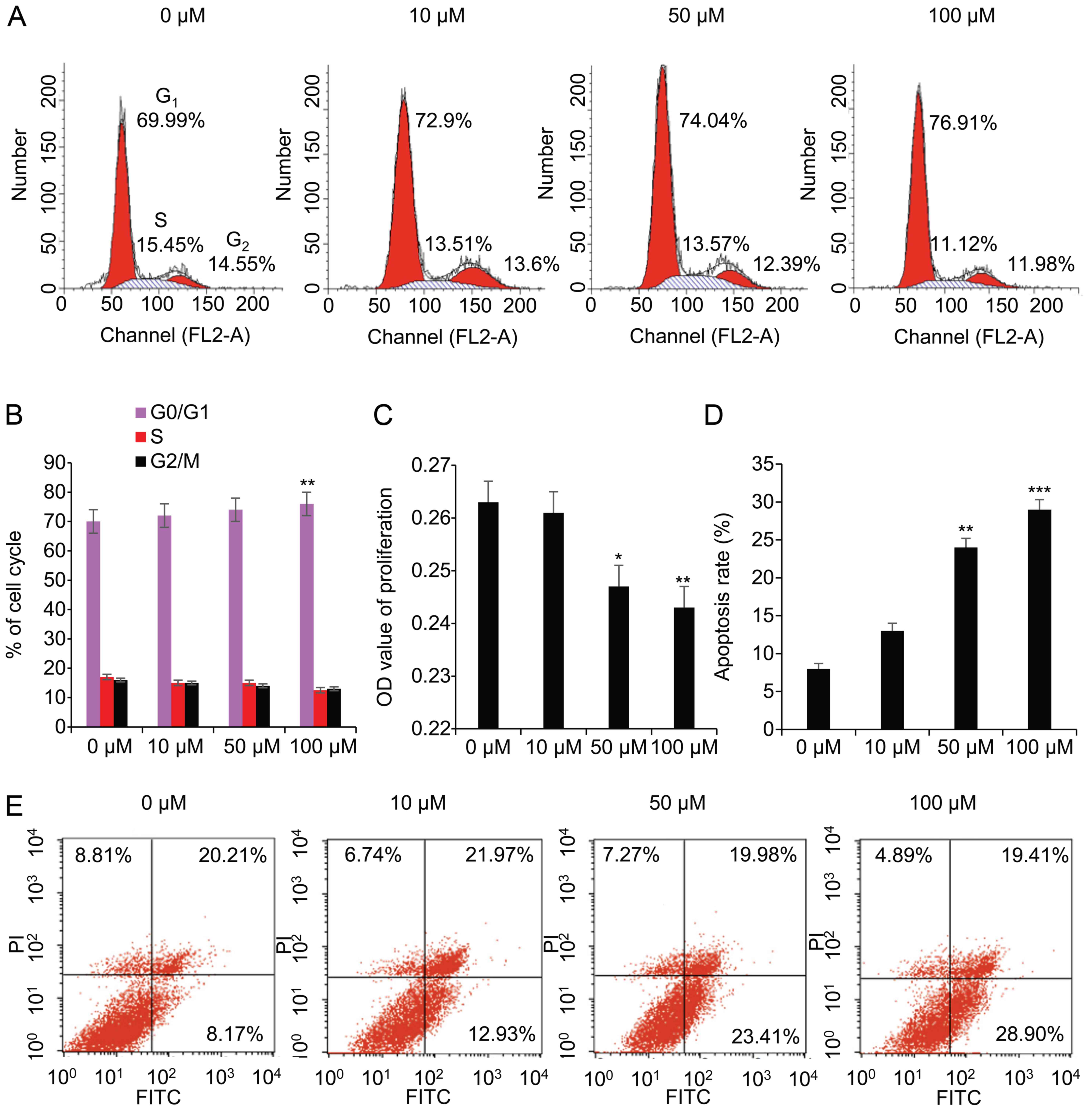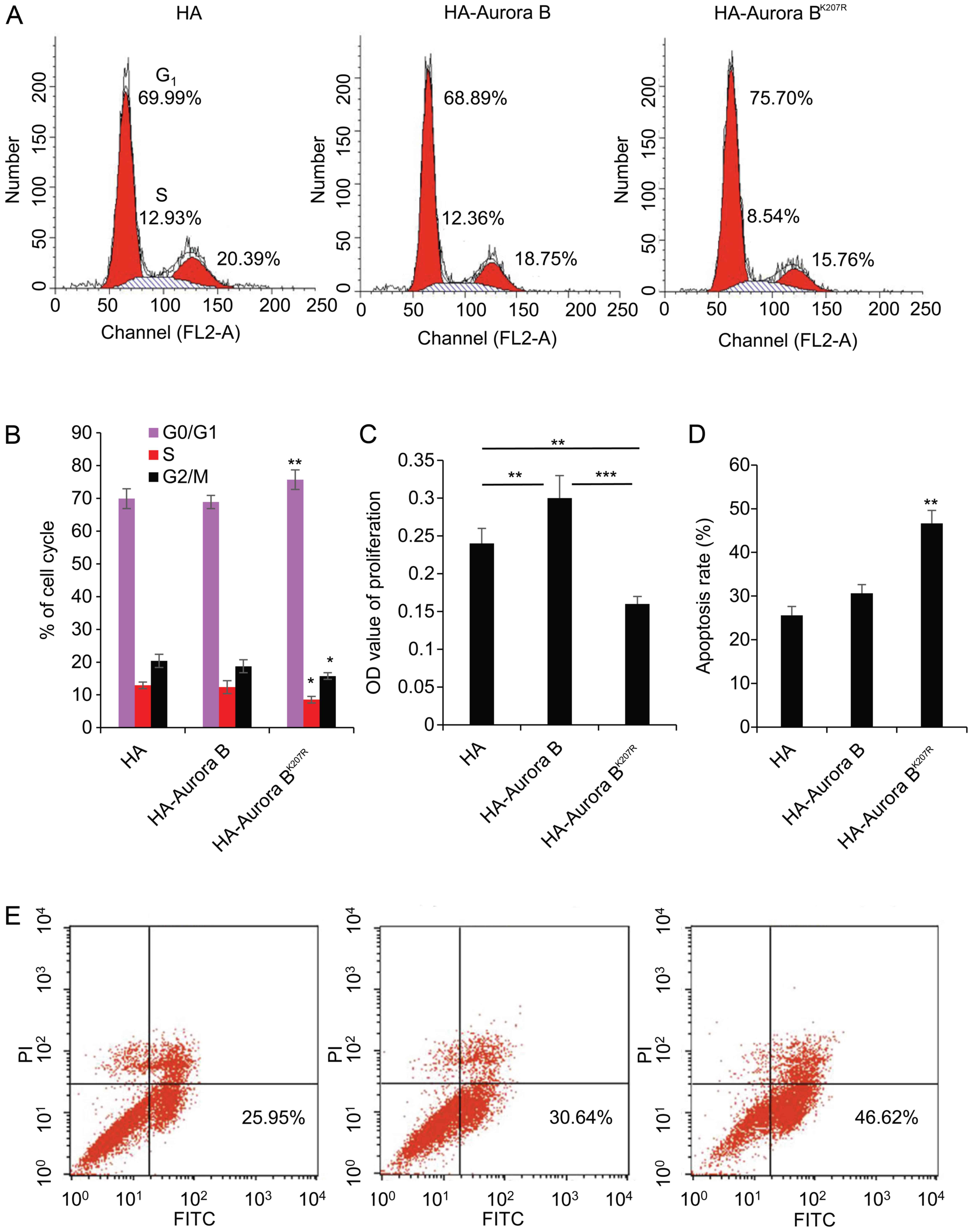|
1
|
Liu XM, Yang FF, Yuan YF, Zhai R and Huo
LJ: SUMOylation of mouse p53b by SUMO-1 promotes its pro-apoptotic
function in ovarian granulosa cells. PLoS One. 8:e636802013.
View Article : Google Scholar : PubMed/NCBI
|
|
2
|
Inoue N, Matsuda F, Goto Y and Manabe N:
Role of cell-death ligand-receptor system of granulosa cells in
selective follicular atresia in porcine ovary. J Reprod Dev.
57:169–175. 2011. View Article : Google Scholar : PubMed/NCBI
|
|
3
|
Porcelli L, Guida G, Quatrale AE, Cocco T,
Sidella L, Maida I, Iacobazzi RM, Ferretta A, Stolfa DA, Strippoli
S, et al: Aurora kinase B inhibition reduces the proliferation of
metastatic melanoma cells and enhances the response to
chemotherapy. J Transl Med. 13:262015. View Article : Google Scholar : PubMed/NCBI
|
|
4
|
Gohard FH, St-Cyr DJ, Tyers M and Earnshaw
WC: Targeting the INCENP IN-box-Aurora B interaction to inhibit CPC
activity in vivo. Open Biol. 4:1401632014. View Article : Google Scholar : PubMed/NCBI
|
|
5
|
Giet R and Glover DM: Drosophila Aurora B
kinase is required for histone H3 phosphorylation and condensin
recruitment during chromosome condensation and to organize the
central spindle during cytokinesis. J Cell Biol. 152:669–682. 2001.
View Article : Google Scholar : PubMed/NCBI
|
|
6
|
Ban R, Nishida T and Urano T: Mitotic
kinase Aurora-B is regulated by SUMO-2/3 conjugation/deconjugation
during mitosis. Genes Cells. 16:652–669. 2011. View Article : Google Scholar : PubMed/NCBI
|
|
7
|
Andrews PD, Knatko E, Moore WJ and Swedlow
JR: Mitotic mechanics: the auroras come into view. Curr Opin Cell
Biol. 15:672–683. 2003. View Article : Google Scholar : PubMed/NCBI
|
|
8
|
Bishop JD and Schumacher JM:
Phosphorylation of the carboxyl terminus of inner centromere
protein (INCENP) by the Aurora B kinase stimulates Aurora B kinase
activity. J Biol Chem. 277:27577–27580. 2002. View Article : Google Scholar : PubMed/NCBI
|
|
9
|
Honda R, Körner R and Nigg EA: Exploring
the functional interactions between Aurora B, INCENP, and survivin
in mitosis. Mol Biol Cell. 14:3325–3341. 2003. View Article : Google Scholar : PubMed/NCBI
|
|
10
|
Hay RT: SUMO: a history of modification.
Mol Cell. 18:1–12. 2005. View Article : Google Scholar : PubMed/NCBI
|
|
11
|
Geiss-Friedlander R and Melchior F:
Concepts in sumoylation: a decade on. Nat Rev Mol Cell Biol.
8:947–956. 2007. View
Article : Google Scholar : PubMed/NCBI
|
|
12
|
Ulrich HD: The fast-growing business of
SUMO chains. Mol Cell. 32:301–305. 2008. View Article : Google Scholar : PubMed/NCBI
|
|
13
|
Klein UR, Haindl M, Nigg EA and Muller S:
RanBP2 and SENP3 function in a mitotic SUMO2/3
conjugation-deconjugation cycle on Borealin. Mol Biol Cell.
20:410–418. 2009. View Article : Google Scholar :
|
|
14
|
Makhnevych T, Sydorskyy Y, Xin X, Srikumar
T, Vizeacoumar FJ, Jeram SM, Li Z, Bahr S, Andrews BJ, Boone C, et
al: Global map of SUMO function revealed by protein-protein
interaction and genetic networks. Mol Cell. 33:124–135. 2009.
View Article : Google Scholar : PubMed/NCBI
|
|
15
|
Kamitani T, Nguyen HP and Yeh ET:
Preferential modification of nuclear proteins by a novel
ubiquitin-like molecule. J Biol Chem. 272:14001–14004. 1997.
View Article : Google Scholar : PubMed/NCBI
|
|
16
|
Sacher M, Pfander B, Hoege C and Jentsch
S: Control of Rad52 recombination activity by double-strand
break-induced SUMO modification. Nat Cell Biol. 8:1284–1290. 2006.
View Article : Google Scholar : PubMed/NCBI
|
|
17
|
Desterro JM, Rodriguez MS and Hay RT:
SUMO-1 modification of IkappaBalpha inhibits NF-kappaB activation.
Mol Cell. 2:233–239. 1998. View Article : Google Scholar : PubMed/NCBI
|
|
18
|
Hoege C, Pfander B, Moldovan GL,
Pyrowolakis G and Jentsch S: RAD6-dependent DNA repair is linked to
modification of PCNA by ubiquitin and SUMO. Nature. 419:135–141.
2002. View Article : Google Scholar : PubMed/NCBI
|
|
19
|
Hay RT: SUMO-specific proteases: a twist
in the tail. Trends Cell Biol. 17:370–376. 2007. View Article : Google Scholar : PubMed/NCBI
|
|
20
|
Fernández-Miranda G, Pérez de Castro I,
Carmena M, Aguirre-Portolés C, Ruchaud S, Fant X, Montoya G,
Earnshaw WC and Malumbres M: SUMOylation modulates the function of
Aurora-B kinase. J Cell Sci. 123:2823–2833. 2010. View Article : Google Scholar : PubMed/NCBI
|
|
21
|
Blomster HA, Hietakangas V, Wu J, Kouvonen
P, Hautaniemi S and Sistonen L: Novel proteomics strategy brings
insight into the prevalence of SUMO-2 target sites. Mol Cell
Proteomics. 8:1382–1390. 2009. View Article : Google Scholar : PubMed/NCBI
|
|
22
|
Golebiowski F, Matic I, Tatham MH, Cole C,
Yin Y, Nakamura A, Cox J, Barton GJ, Mann M and Hay RT: System-wide
changes to SUMO modifications in response to heat shock. Sci
Signal. 2:ra242009. View Article : Google Scholar : PubMed/NCBI
|
|
23
|
Hsiao HH, Meulmeester E, Frank BT,
Melchior F and Urlaub H: 'ChopNSpice', a mass spectrometric
approach that allows identification of endogenous small
ubiquitin-like modifier-conjugated peptides. Mol Cell Proteomics.
8:2664–2675. 2009. View Article : Google Scholar : PubMed/NCBI
|
|
24
|
Blomster HA, Imanishi SY, Siimes J, Kastu
J, Morrice NA, Eriksson JE and Sistonen L: In vivo identification
of sumoylation sites by a signature tag and cysteine-targeted
affinity purification. J Biol Chem. 285:19324–19329. 2010.
View Article : Google Scholar : PubMed/NCBI
|
|
25
|
Davies EJ, Dong M, Gutekunst M, Närhi K,
Van Zoggel HJ, Blom S, Nagaraj A, Metsalu T, Oswald E,
Erkens-Schulze S, et al: Capturing complex tumour biology in vitro:
histological and molecular characterisation of precision cut
slices. Sci Rep. 5:171872015. View Article : Google Scholar : PubMed/NCBI
|
|
26
|
KJ and Schmittgen TD: Analysis of relative
gene expression data using real-time quantitative PCR and the
2-ΔΔCT method. Methods. 25:402–408. 2001. View Article : Google Scholar
|
|
27
|
Hauf S, Cole RW, LaTerra S, Zimmer C,
Schnapp G, Walter R, Heckel A, Van Meel J, Rieder CL and Peters JM:
The small molecule Hesperadin reveals a role for Aurora B in
correcting kinetochore-microtubule attachment and in maintaining
the spindle assembly checkpoint. J Cell Biol. 161:281–294. 2003.
View Article : Google Scholar : PubMed/NCBI
|
|
28
|
Carmena M and Earnshaw WC: The cellular
geography of aurora kinases. Nat Rev Mol Cell Biol. 4:842–854.
2003. View Article : Google Scholar : PubMed/NCBI
|
|
29
|
Kouraklis G, Theocharis S, Vamvakas P,
Vagianos C, Glinavou A, Giaginis C and Sioka C: Cyclin D1 and Rb
protein expression and their correlation with prognosis in patients
with colon cancer. World J Surg Oncol. 4:52006. View Article : Google Scholar : PubMed/NCBI
|
|
30
|
Rader J, Russell MR, Hart LS, Nakazawa MS,
Belcastro LT, Martinez D, Li Y, Carpenter EL, Attiyeh EF, Diskin
SJ, et al: Dual CDK4/CDK6 inhibition induces cell-cycle arrest and
senescence in neuroblastoma. Clin Cancer Res. 19:6173–6182. 2013.
View Article : Google Scholar : PubMed/NCBI
|
|
31
|
Rihani A, Vandesompele J, Speleman F and
Van Maerken T: Inhibition of CDK4/6 as a novel therapeutic option
for neuroblastoma. Cancer Cell Int. 15:762015. View Article : Google Scholar : PubMed/NCBI
|
|
32
|
Wang YN, Xiao KQ, Liu JL, Dallner G and
Guan ZZ: Effect of long term fluoride exposure on lipid composition
in rat liver. Toxicology. 146:161–169. 2000. View Article : Google Scholar : PubMed/NCBI
|
|
33
|
Bukholm IK and Nesland JM: Protein
expression of p53, p21 (WAF1/CIP1), bcl-2, Bax, cyclin D1 and pRb
in human colon carcinomas. Virchows Arch. 436:224–228. 2000.
View Article : Google Scholar : PubMed/NCBI
|
|
34
|
Elkady AI, Hussein RA and El-Assouli SM:
Mechanism of action of Nigella sativa on human colon cancer cells:
the suppression of AP-1 and NF-kappaB transcription factors and the
induction of cytoprotective genes. Asian Pac J Cancer Prev.
16:7943–7957. 2015. View Article : Google Scholar
|
|
35
|
Kollareddy M, Dimitrova E, Vallabhaneni
KC, Chan A, Le T, Chauhan KM, Carrero ZI, Ramakrishnan G, Watabe K,
Haupt Y, et al: Regulation of nucleotide metabolism by mutant p53
contributes to its gain-of-function activities. Nat Commun.
6:73892015. View Article : Google Scholar : PubMed/NCBI
|
|
36
|
Zhu J, Sammons MA, Donahue G, Dou Z,
Vedadi M, Getlik M, Barsyte-Lovejoy D, Al-awar R, Katona BW,
Shilatifard A, et al: Gain-of-function p53 mutants co-opt chromatin
pathways to drive cancer growth. Nature. 525:206–211. 2015.
View Article : Google Scholar : PubMed/NCBI
|
|
37
|
Tsou SH, Hou MH, Hsu LC, Chen TM and Chen
YH: Gain-of-function p53 mutant with 21-bp deletion confers
susceptibility to multidrug resistance in MCF-7 cells. Int J Mol
Med. 37:233–242. 2016. View Article : Google Scholar
|
|
38
|
Quirk SM, Cowan RG, Joshi SG and Henrikson
KP: Fas anti- gen-mediated apoptosis in human granulosa/luteal
cells. Biol Reprod. 52:279–287. 1995. View Article : Google Scholar : PubMed/NCBI
|
|
39
|
Quirk SM, Cowan RG and Huber SH: Fas
antigen-mediated apoptosis of ovarian surface epithelial cells.
Endocrinology. 138:4558–4566. 1997. View Article : Google Scholar : PubMed/NCBI
|
|
40
|
Quirk SM, Porter DA, Huber SC and Cowan
RG: Potentiation of Fas-mediated apoptosis of murine granulosa
cells by interferon-gamma, tumor necrosis factor-alpha, and
cycloheximide. Endocrinology. 139:4860–4869. 1998. View Article : Google Scholar : PubMed/NCBI
|
|
41
|
Vickers SL, Cowan RG, Harman RM, Porter DA
and Quirk SM: Expression and activity of the Fas antigen in bovine
ovarian follicle cells. Biol Reprod. 62:54–61. 2000. View Article : Google Scholar
|















